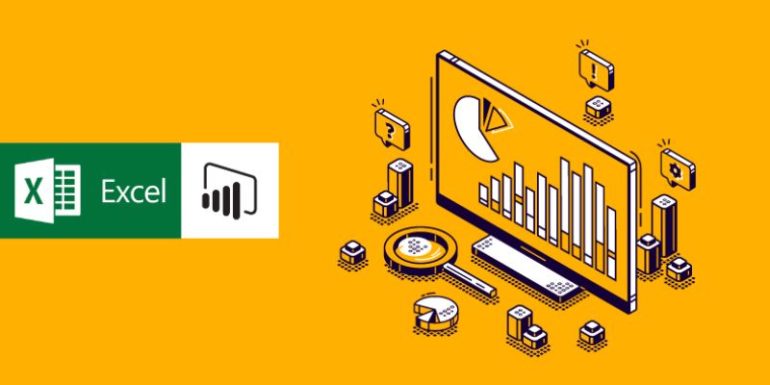Excel has been a staple tool for managing and analyzing data for years. It’s widely known for its ease of use and flexibility, making it a favorite among professionals. However, with the growing need for more advanced data analytics, Power BI has emerged as a game-changer. If you’re an Excel user and want to take your data skills to the next level. Then Power BI offers many features that work well with Excel’s capabilities.
In this blog, we’ll explore the top five Power BI features that every Excel user should know, especially if you’re taking an Advanced Excel Course in Bangalore and looking to expand your skills.
1. Power Query: Excel’s Data Cleaning Tool, Supercharged
If you’ve ever used Power Query in Excel to clean and transform data, you’ll be glad to know that Power BI includes this powerful feature. Power Query helps you bring in data, clean it up, and reshape it for analysis, saving you hours of manual work.
Why It Matters for Excel Users:
In Power BI, Power Query works just like in Excel but with extra power. You can connect to even more data sources and handle larger datasets more efficiently. Plus, once your data is cleaned up, Power BI automatically updates your reports whenever new data comes in.
Pro Tip: You can even copy existing queries from Excel into Power BI for seamless integration.
2. DAX (Data Analysis Expressions): Advanced Calculations Beyond Excel Formulas
Excel users love using formulas like SUM, AVERAGE, and VLOOKUP to perform calculations. Power BI introduces DAX (Data Analysis Expressions), which allows you to create even more complex calculations and gain deeper insights from your data.
Why It Matters for Excel Users:
While Excel formulas are great for basic calculations, DAX allows you to create custom calculations that can analyze data in much more advanced ways. With DAX, you can easily perform time-based calculations, comparisons between data sets, and dynamic measures that respond to filters.
Pro Tip: If you’ve already worked with Excel formulas during your Power BI Training in Bangalore, learning DAX will feel like a natural next step. DAX builds on the logic of Excel formulas, so the learning curve isn’t steep.
3. Data Visualization: Interactive Dashboards That Go Beyond Excel Charts
Excel offers a range of chart types, but Power BI takes data visualization to the next level. Power BI is designed to create visually stunning and interactive reports that allow users to explore data in real-time.
Why It Matters for Excel Users:
In Power BI, you can create dynamic dashboards that update automatically and respond to user interactions. For example, you can click on a chart segment to filter data or drill down into more detailed information. Power BI visualizations are not only more advanced than Excel charts but also easier to share and interact with.
Pro Tip: If you’ve created charts in Excel, you’ll find Power BI’s interface intuitive and easy to use. You can even import your Excel files directly into Power BI and transform them into interactive reports. This is something you might touch upon during your Power Bi Training in Marathahalli, but Power BI takes it a step further with enhanced capabilities.
4. Data Modeling: Easy Connections Between Different Data Sources
In Excel, linking data from different sheets or files can be done using VLOOKUP or INDEX-MATCH. Power BI simplifies this process through data modeling, where you can easily create relationships between multiple tables or data sources.
Why It Matters for Excel Users:
Power BI’s data modeling feature allows you to connect and analyze data from different sources without complicated formulas. If you’re working with multiple datasets—such as sales data, customer data, and inventory—you can easily build relationships between them to get a complete view of your business.
Pro Tip: In Power BI, this process is even simpler and more powerful, allowing for better analysis and richer insights across multiple data sources.
5. Data Connectivity: A Broader Range of Data Sources
While Excel allows you to connect to common data sources like CSV files and databases, Power BI expands on this by offering a much wider range of data connections. You can pull data from cloud platforms, APIs, web services, and even live databases in real-time.
Why It Matters for Excel Users:
With Power BI, you can easily connect to almost any data source, including popular platforms like Google Analytics, Salesforce, Azure, and more. This means you can bring in data from various sources and have it all in one place, updated in real-time without needing to manually import data.
Pro Tip: Once connected, your data can be automatically refreshed, so your reports are always up to date.
Power BI is a powerful tool that enhances and complements what you already know in Excel. From advanced data cleaning with Power Query to dynamic dashboards and interactive reports, Power BI opens up new possibilities for data analysis. If you’re currently learning Excel or have taken Training Institute in Bangalore, transitioning to Power BI will allow you to build on those skills and take your data analysis capabilities to the next level.
By mastering these key Power BI features, you’ll be well-equipped to handle modern data challenges and make more informed decisions based on real-time insights. So, whether you’re already comfortable in Excel or just getting started, Power BI is the perfect next step in your data journey.
Also Check: Excel Interview Questions and Answers

